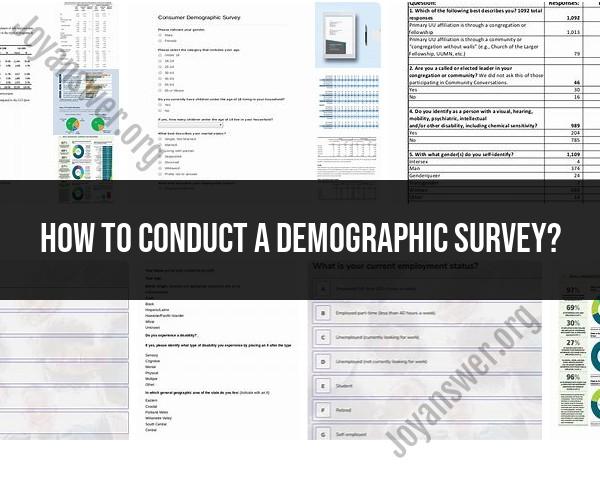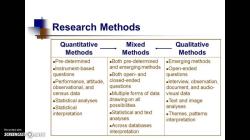How to conduct a demographic survey?
Conducting a demographic survey involves gathering data about the characteristics of a specific population, such as age, gender, ethnicity, income, education, and more. Here's a step-by-step guide on how to conduct a demographic survey:
Define Your Objectives:
- Clearly define the goals and objectives of your survey. What specific demographic information are you trying to collect, and why is it important? Having a clear purpose will guide the survey design and data analysis.
Select Your Target Population:
- Determine the group or community you want to survey. Ensure that your survey's scope is well-defined, and the target population is clearly identified.
Choose the Survey Method:
- Decide on the method of data collection. There are several options, including online surveys, phone interviews, in-person interviews, or mailed questionnaires. The choice depends on your target population and available resources.
Design the Survey Questionnaire:
- Create a questionnaire that includes questions related to the demographic information you want to collect. Ensure that your questions are clear, concise, and do not invade personal privacy.
Pilot Test the Survey:
- Conduct a small-scale pilot test of your survey with a sample of people who are similar to your target population. This will help identify any issues with the survey questions, design, or instructions.
Administer the Survey:
- Implement the survey to your target population. This can be done through various channels, such as online survey platforms, phone calls, in-person interviews, or mailed questionnaires.
Ensure Data Privacy and Informed Consent:
- If your survey collects personally identifiable information, ensure that you have proper data protection measures in place. Obtain informed consent from participants, explaining the purpose of the survey, how their data will be used, and how their privacy will be protected.
Data Collection and Management:
- Collect and store the data securely. Use appropriate data management software or tools to keep responses organized and easily accessible for analysis.
Analyze the Data:
- After data collection, conduct data analysis to identify trends and patterns. Use statistical software if necessary.
Report the Findings:
- Create a report summarizing the survey results, including key demographic information. Use graphs, charts, and tables to present the data effectively.
Interpret the Data:
- Interpret the findings in the context of your research objectives. What do the demographic data reveal about the target population?
Use the Data:
- Apply the insights gained from the survey to inform your decision-making, whether it's for marketing, policy development, academic research, or other purposes.
Respect Privacy and Data Security:
- Maintain the privacy and security of the collected data. If it includes sensitive information, ensure that it is handled according to applicable data protection laws and ethical standards.
Follow-Up and Future Surveys:
- Consider conducting follow-up surveys at regular intervals to track demographic changes or trends in the population.
Disseminate the Results:
- Share the results of the survey with stakeholders or the broader community, as appropriate, to contribute to informed decision-making or public awareness.
When conducting a demographic survey, it's essential to ensure the quality and integrity of the data, maintain ethical standards, and use the information collected for positive and productive purposes.
Conducting a Demographic Survey: A Step-by-Step Guide
Here is a step-by-step guide to conducting a demographic survey:
- Define your goals. What do you want to learn from your survey? Once you know your goals, you can develop specific survey questions.
- Identify your target audience. Who are you trying to reach with your survey? Once you know your target audience, you can choose a survey distribution method that is likely to reach them.
- Develop your survey questions. Your survey questions should be clear, concise, and easy to understand. Avoid using jargon or leading questions.
- Test your survey. Once you have developed your survey questions, test them out on a small group of people to make sure they are easy to understand and that the results are useful.
- Distribute your survey. There are many different ways to distribute your survey, such as online, in person, or by mail. Choose a distribution method that is likely to reach your target audience.
- Collect your data. Once you have distributed your survey, collect the data from respondents. You can use a variety of tools to collect your data, such as online survey software, paper surveys, or phone interviews.
- Analyze your data. Once you have collected your data, you need to analyze it to identify trends and patterns. You can use a variety of statistical tools to analyze your data.
- Interpret your results. Once you have analyzed your data, you need to interpret the results and draw conclusions. Be sure to consider the limitations of your study when interpreting the results.
- Disseminate your findings. Once you have interpreted your results, you need to disseminate your findings to the appropriate stakeholders. This may involve writing a report, giving a presentation, or publishing your results in a journal article.
Planning and Designing an Effective Demographic Survey
When planning and designing a demographic survey, it is important to keep the following things in mind:
- Identify your target audience. Who are you trying to reach with your survey? Once you know your target audience, you can choose a survey distribution method that is likely to reach them.
- Develop clear and concise survey questions. Your survey questions should be easy to understand and should not be leading.
- Test your survey before distributing it. Test your survey out on a small group of people to make sure it is easy to understand and that the results are useful.
- Choose a survey distribution method that is likely to reach your target audience. There are many different ways to distribute a survey, such as online, in person, or by mail.
- Incentivize participation. Offering an incentive, such as a gift card or a discount, can encourage people to participate in your survey.
Collecting, Analyzing, and Interpreting Demographic Data
Once you have collected your demographic data, you need to analyze it to identify trends and patterns. You can use a variety of statistical tools to analyze your data.
When interpreting your results, it is important to consider the limitations of your study. For example, if your sample size was small, you should be cautious about generalizing your results to the larger population.
Utilizing Demographic Survey Results for Decision-Making
Demographic survey results can be used to inform decision-making in a variety of ways. For example, businesses can use demographic survey results to develop new products and services, target their marketing campaigns, and make informed decisions about where to locate their stores.
Government agencies can use demographic survey results to develop policies and programs that meet the needs of their constituents.
Ethical Considerations and Best Practices in Demographic Research
When conducting demographic research, it is important to follow ethical guidelines. These guidelines include:
- Obtaining informed consent from participants.
- Protecting the privacy and confidentiality of participants.
- Avoiding harm to participants.
- Reporting results in a fair and honest manner.
In addition to ethical guidelines, there are also a number of best practices to follow in demographic research. These best practices include:
- Using a valid and reliable survey instrument.
- Collecting a representative sample of participants.
- Using appropriate statistical methods to analyze the data.
- Reporting the results of the study in a clear and concise manner.
By following these ethical considerations and best practices, you can conduct demographic research that is informative, ethical, and useful.












